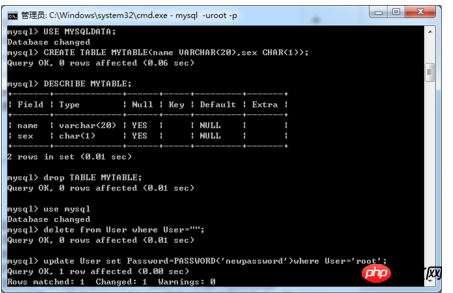
Experiment in the command prompt.
1: Use the SHOW statement to find out what database currently exists on the server:
mysql> SHOW DATABASES;
2:2. Create a database MYSQLDATA
mysql> CREATE DATABASE MYSQLDATA;
3: Select the database you created
mysql> USE MYSQLDATA; (按回车键出现Database changed 时说明操作成功!)
4: Check what tables exist in the current database
mysql> SHOW TABLES;
5: Create a database table
mysql> CREATE TABLE MYTABLE (name VARCHAR(20), sex CHAR(1));
6: Display the structure of the table:
mysql> DESCRIBE MYTABLE;
##7: Go Add records to the table
mysql> insert into MYTABLE values (”hyq”,”M”);
mysql> LOAD DATA LOCAL INFILE “D:/mysql.txt” INTO TABLE MYTABLE;
mysql>use database; mysql>source d:/mysql.sql;
mysql>drop TABLE MYTABLE;
mysql>delete from MYTABLE;
mysql>update MYTABLE set sex=”f” where name=’hyq’;
2. In Windows, MySql exists as a service. Before using it, make sure that the service has been started. If it is not started, you can use the net start mysql command to start it. When starting in Linux, you can use the "/etc/rc.d/init.d/mysqld start" command. Note that the initiator should have administrator rights.

use mysql;
delete from User where User=”";
update User set Password=PASSWORD(’newpassword’) where User=’root’;
mysql -uroot -p;
mysql -uroot -pnewpassword;
mysql mydb -uroot -p;
mysql mydb -uroot -pnewpassword;
The above command parameters are part of the commonly used parameters. For details, please refer to the documentation. Mydb here is the name of the database to log in to.
Global management permissions: ##FILE: Read and write files on the MySQL server. CREATE: Create a new database or data table. DELETE: Delete records from the table. DROP: Delete a data table or database. INDEX: Create or delete an index. INSERT: Add records to the table. SELECT: Display/search the records of the table. UPDATE: Modify existing records in the table. Special permissions: ALL: Allowed to do anything (same as root). USAGE: Only allowed to log in – nothing else is allowed. Note To give this user the ability to manage his permissions on the corresponding object, you can add WITH GRANT OPTION after GRANT options. The above is the detailed content of Sharing of commonly used commands in MySQL. For more information, please follow other related articles on the PHP Chinese website!grant all on mydb.* to NewUserName@HostName identified by “password” ;
grant usage on *.* to NewUserName@HostName identified by “password”;
grant select,insert,update on mydb.* to NewUserName@HostName identified by “password”;
grant update,delete on mydb.TestTable to NewUserName@HostName identified by “password”;





